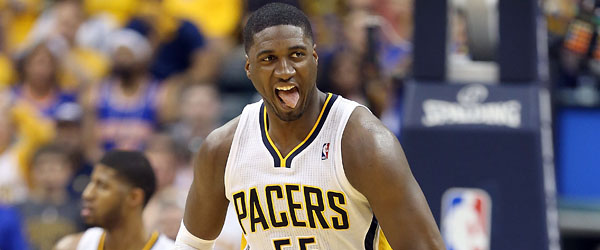The NBA slogan “Go Big or Go Home” definitely applies to the 2013 playoffs because three of the four teams left have one thing in common: They’re big.
The Indiana Pacers are in the Eastern Conference finals thanks in large part to 7-foot-2 center Roy Hibbert. The Memphis Grizzlies are in the Western Conference finals for the first time in franchise history because of Marc Gasol and Zach Randolph, arguably the best center-power forward tandem in the Association. The San Antonio Spurs are back in the West finals for the eighth time in Tim Duncan’s 16-year career mainly because of the emergence of 6-11 center Tiago Splitter.
The Miami Heat are the only team left in the 2013 playoffs that prefers small ball, but they have four-time league MVP LeBron James. What makes Miami the exception to the rule is LeBron’s ability to fill two roles: power forward and point guard. LeBron is not only the best power forward in basketball, but he’s also the best point-forward in basketball.
For the past few years NBA coaches have become enamored with small lineups, moving small forwards to the power forward spot and turning shooting guards into small forwards. The term “stretch 4” is like that new mobile app everyone is downloading, as more and more teams look for big men who prefer to play out in the perimeter instead of the low post.
But like all trends, they tend to fade away. Remember the “wildcat” offense in the NFL? It was so popular two years ago, now you hardly see it. The same can be said about “small ball” in the NBA. It took off during the 2004-05 season when Mike D’Antoni unveiled it in Phoenix and several teams embraced it, including the last two NBA champions: Dallas and Miami.
Entering the 2013 playoffs, the Denver Nuggets, Golden State Warriors, New York Knicks, Houston Rockets, and the Oklahoma City Thunder all ran a variation of the small-ball concept. They play an up-tempo, exciting brand of basketball that seemingly filtered around the league. However, all of them are now home watching the playoffs.
Small ball has taken a huge hit this postseason, none more evident than the New York-Indiana series in the Eastern Conference semifinals. The Knicks were absolutely pounded on the boards by the big, bad Pacers with a traditional frontline that includes Hibbert, 6-9 power forward David West, and 6-10 small forward Paul George. The size and length of the Pacers eventually wore down the Knicks, as Indy won the series in six games. The Knicks’ bread-and-butter was the 3-point shot, and when that was taken away they struggled to score points.
“You always construct your team to beat the world champions, which is the Miami Heat. But nobody thought about the Indiana Pacers,” Knicks superfan Spike Lee said on ESPN’s First Take. “We were not constructed to deal with them dudes. They’re too big, too strong, and they’re young. So, we were looking at Miami but were sleeping on the Pacers.”
The Pacers pounded the Knicks on the boards, outrebounding them 269-222 in the series. After the Pacers outworked the Knicks 53-40 in Game 3, New York coach Mike Woodson ditched his small-ball starting lineup in favor of a more traditional lineup, as he paired Kenyon Martin with Tyson Chandler. But it didn’t matter who Woodson threw out there. Hibbert and West were too much. Hibbert was a beast on both ends, tipping in missed shots on offense and shutting down Knicks drives on defense.
“The beauty of this team is we really don’t adjust to other teams,” Pacers coach Frank Vogel said. “We do what we do in terms of our starting lineup and our rotations.”
The signature play of the series came with five minutes left in the fourth quarter of Game 6 and the Knicks ahead 92-90. Carmelo Anthony spun past George on the baseline and thought he had a clear path to the basket. Hibbert met him at the rim and rejected Anthony’s potential dunk with his left hand. That play sparked a 7-0 run by the Pacers and eventually closed out the Knicks’ season.
Hibbert was simply too big and too strong for the Knicks. That’s been the theme of this year’s playoffs.
